Mobile applications have evolved drastically over the years.
While there was a time when you had to install multiple applications just to get a series of tasks done, today you can find different services in a single application.
These single applications that cover a plethora of services are referred to as Super apps.
Super apps have certainly defied the concept of niches in mobile apps, as today, a payments app can also offer travel booking services, while a food delivery application can also offer an integrated handyman service. The possibilities are endless!
So how do these apps work? What industries does it cover? What are the benefits of developing a super app?
If you have similar questions in your head and want to know everything about super apps, then this is the post for you!
Without further ado, let’s get started!
Understanding Super Apps: An Overview
The concept of Super Apps is certainly fascinating and helpful for the user, as it reduces the hassle of switching between multiple apps to get something done.
Not only does it allow a user to get things done faster, but it also opens new doors of expansion for a service provider.
If we talk about the market, the super apps market in 2025 is valued at $127.46 billion and is expected to reach $440.19 billion by 2030, with a CAGR of 28.13%. The numbers clearly show the potential of launching your own super app.
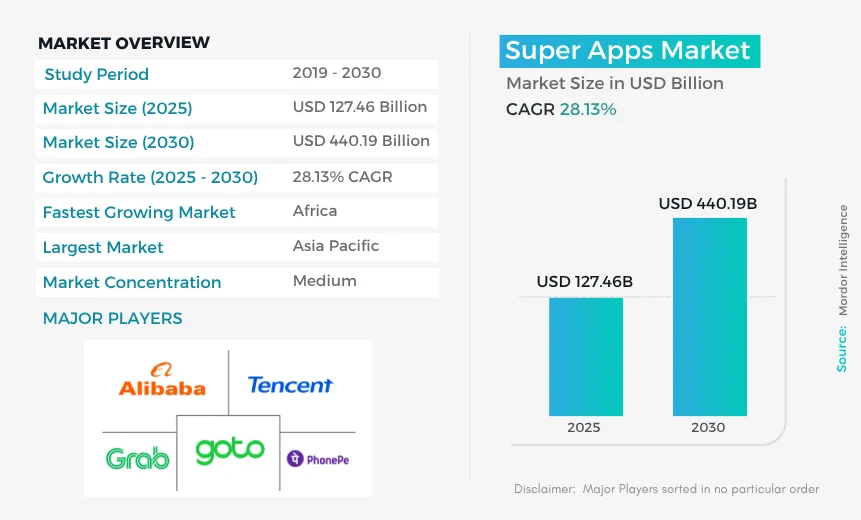
With multiple industries in the same app, the businesses get a chance to improve their user retention, which is why super apps have gained popularity.
All in all, a super app is mobile app development on steroids. Bringing everything to one place, creating a virtual mall, where users can find anything and everything they want.
Types of Super Apps
Super apps can be divided based on two classifications:-
- Based on Target Users
- Based on Target Industries
If we talk about the types of super apps based on target users, there are two types of super apps.
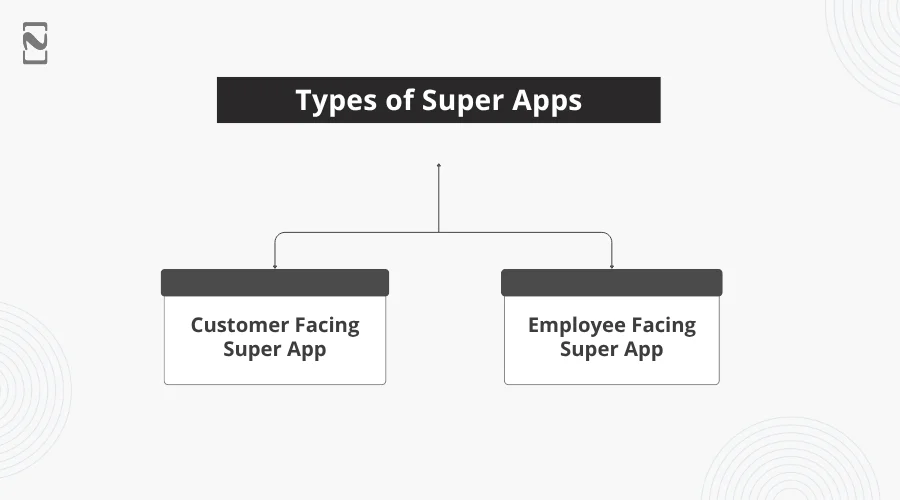
These are –
1. Customer Facing Super App
As the name implies, a customer-facing app is a platform where services are targeted towards customers.
In other words, it is a B2C business model. The reason is that, in this type, we have a business like Uber or Amazon that is offering its solution to common people who become the audience base.
The majority of the super apps fall under this category, including WeChat, Gojek, and so on.
2. Employee Facing Super App
In contrast to customer-facing apps, employee-facing super apps are developed by businesses for internal use, for their employees.
One of the top examples is Me@Walmart, which helps employees en route, manage their schedules, ask for time off, access other benefits, and more.
On the other hand, the second classification is based on the industry that it caters to.
Super apps may include the following (but are not limited to):
- ECommerce
- eWallet
- Food Delivery
- Grocery Delivery
- Taxi Booking
And so on. Let’s move to the next section to understand exactly what industries can be integrated into a super app.
What Industries Can You Integrate into Your Super App?
Identifying the right combination of services is the key to a successful super app.
Now, there are several industries and services that can be integrated into a super app. However, of the industries that are popularly used, you might end up making the wrong choices.
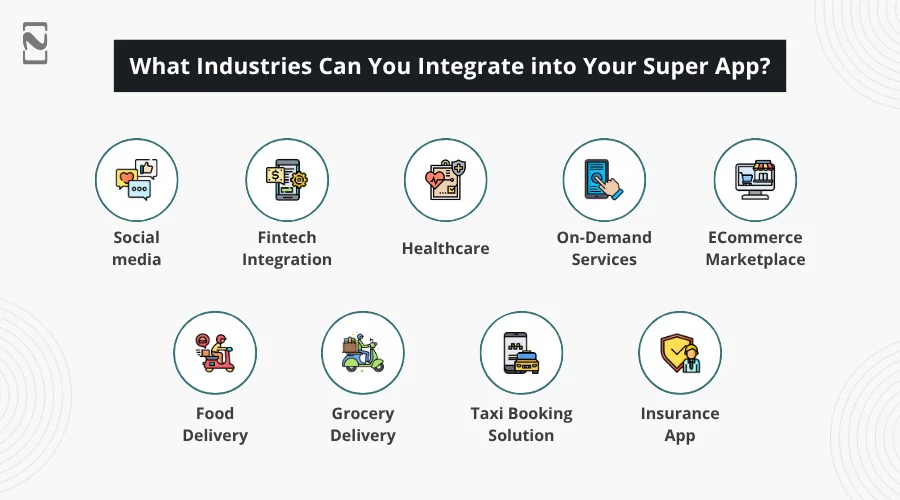
Some of the industries that you can target to launch a super app are, as mentioned below:
-
Social media
It is said that the 21st century is the age of social media, and rightfully so. Thus, by integrating this into your super app, you can open doors to a lot of benefits.
The growing social media user base is a good opportunity for a startup or even a well-established business to boost the popularity of their platform.
While integrating a full-fledged social media application into a super app may not be possible, you can certainly add social features. Adding an in-app messaging or feed feature can certainly elevate the experience for your users while helping you improve retention.
-
Fintech Integration
The rise of fintech apps to fame and market success is no secret. We have seen how it has helped top platforms improve, grow, and generate revenue.
Since the majority of super apps offer a paid service, it only makes sense that they also offer an integrated financial solution to simplify payments.
A good example of fintech integration is Amazon with its Amazon Pay solution.
Fintech transactions can take a lot of time for users; you can make it seamless by providing banking & finance management in your app. You can offer them different services through it, like adding your bank account, checking balance, and many more.
-
Healthcare
Digital healthcare solutions like remote patient monitoring apps and doctor-on-demand apps have become common, thanks to the ease of internet access.
And it’s not like there is no need for these platforms; rather, the need and demand for healthcare solutions is rising at an immense rate.
That’s why we recommend you integrate digital healthcare solutions, like on-demand medicine delivery or one of the other top healthcare app ideas, into your super app.
-
On-Demand Services
With the rise of on-demand app development, almost every super app has introduced delivery services.
As a business, you will surely agree that users love convenience and comfort. To deliver this, you can offer on-demand delivery services when you make your super app.
-
ECommerce Marketplace
With fast-forward fashion, e-commerce app development services are gaining momentum right now. E-commerce has become a multi-billion-dollar industry.
Integrating e-commerce into your super app not only helps you expand your scope of business but also helps in improving the retention time, as when buying things, people tend to spend a lot of time on your platform, making it highly profitable for you in the long run.
-
Food delivery
Food delivery apps like DoorDash have become common for modern users.
People today prefer staying at home and enjoying their favorite food, rather than travelling all the way to the restaurant.
This is also the reason why integrating food delivery in your super app or developing an app around restaurant delivery is a vital decision.
Food delivery has seen vast growth in the past few years, so getting this category in your super app will be useful. It will also motivate your users to stay a little longer on your app and choose from the diverse options.
-
Grocery Delivery
Grocery delivery solutions like Instacart can be integrated into your on-demand super app development.
It saves their effort & time and redefines grocery shopping by providing a top-notch experience.
You can use this category to help users save time and streamline the entire process of buying groceries without leaving their houses.
-
Taxi Booking Solution
Several ride-sharing apps like Grab have gained the attention of users and are used a lot by them. This surely means people want assistance with their transportation needs.
You can offer a Taxi booking solution to book rides, real-time tracking, scheduling rides for different times, choosing from different vehicle options, etc.
-
Insurance App
Well, since you want to create a super app where users can find all they need, it’s just to include an insurance app.
Well, if you want to create a super app, integrating categories that are helpful for users and often used by customers will be a good choice.
You should include the insurance category in your super app. The market is currently worth trillions, and adding this will surely help to generate good revenue.
Other than these, a complete mix and match of these categories can lead you to a well-designed super app. It may seem a bit typical to merge multiple niches into a single application; however, it is certainly beneficial in many ways. How? Let’s find out in the next section.
Why Invest in a Super App? Benefits of Developing Super Apps
When we talk about investing in a mobile app, almost every entrepreneur, every business thinks of making an app that is in their niche and supports their existing operations.
No one directly gives a thought to developing a super app. This is because they are unaware of the benefits that building a super app can offer for their growth.
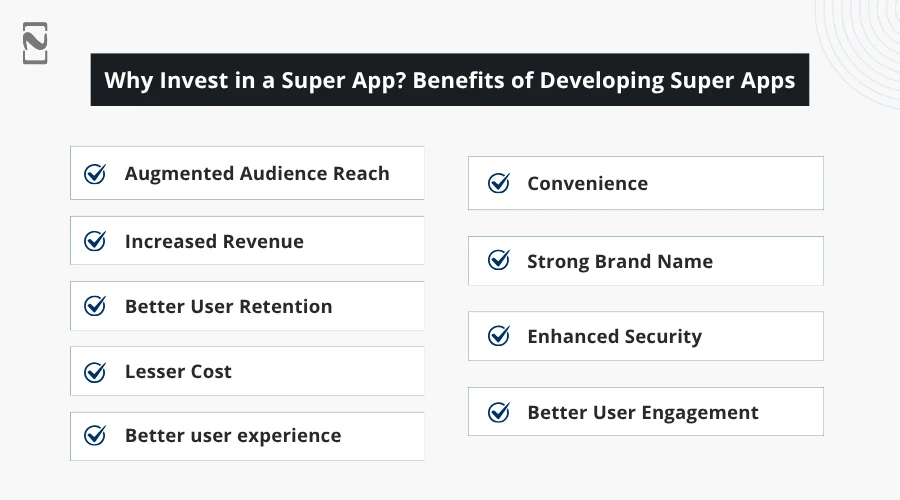
If you are also looking to identify these benefits and want to understand exactly why investing in a super app is vital, then check out the following benefits that we have listed!
1. Augmented Audience Reach
Users only run around when they have to use a service that’s not present in an app.
By covering so many industries and niches in a single place, you are providing them with an app for their every need.
Therefore, it is a good idea to integrate useful services into your super app if you want to keep your users coming back and get exposure to a larger customer base.
This greatly helps multiply the revenue in no time.
2. Convenience
A super app is a hub for doing a lot of activities, providing necessary features in one place, and helping to do tasks more conveniently and easily.
It eliminates the need to scroll around and use another app. Whether you want to do shopping, pay your bill, or book a taxi, everything is available in one place with just a tap away.
This convenience allows you to attract more customers and improve conversions in the long run.
3. Increased Revenue
Super Apps are one of the most viable options to create a loyal customer base and enjoy the revenue. Why? Because it is not limited to just a single industry.
By entering into different industries and niches, businesses can tap into unused opportunities and deliver exceptional services to their customers. This will create room for a lot of revenue.
4. Strong Brand Name
Building a super app helps you establish your name strongly in the market.
The best example of this can be Careem, an app in the UAE that offers its users everything they need, from cabs to food deliveries.
While the company is relatively new, the brand identity has grown significantly as almost every type of user has interacted with the app.
Building a super app helps you gain the attention of users, making it easier for you to establish your brand.
5. Better User Retention
You can attract customers initially, but keeping them hooked on your app is the key to your success. Super applications offer a better opportunity to keep your users coming back to the application.
Not only that, a super app also makes sure that the engagement is high, thanks to different services integrated in a single app.
Think of it this way, if a user were choosing something to buy on your platform and then decided to watch a movie, they might switch from your app to go and book the tickets.
However, if your app is a super app and offers bookings too, all he does is switch to the booking feature and stays on your app.
That is how your retention becomes better!
6. Enhanced Security
There is a lot of data transmission and payments happening on the Super Apps. This calls for extra mobile app security.
With access to so much data and information, the app becomes a target for resourceful thieves.
These super app services communicate via APIs. To protect this data, one can save it in a secure environment and remove access to scattered data across unsafe networks.
This results in promoting secure communication between users with the app.
7. Lesser Cost
By providing all services in one place, businesses can eliminate the need to pay for several business apps. The cost of building a super app is still less than having multiple apps.
This also reduces the cost of maintenance and support, leading to a more efficient way of operating a single app.
Furthermore, this can help businesses to automate offerings like customer support simply and conveniently.
8. Better User Engagement
If you are providing a handful of third-party services in an app, it will remove the need to switch to another app.
From ordering food to booking a taxi can bring together different journeys and interactions into one rational interface and help them have a better user experience.
This also lets users explore your app however they want to shape their user experience in favor of your business.
9. Better User Experience
If you are providing a handful of third-party services in an app, it will remove the need to switch to another app.
From ordering food to booking a taxi can bring together different journeys and interactions into one rational interface and help them have a better user experience.
This also lets users explore your app however they want to shape their user experience in favor of your business.
Integrational Challenges in Super App Development
When defining a super app, it is clear that it combines different types of solutions, all in one single user interface.
Now, when you want to develop a super app, you must identify the key objectives, features, and functionalities you want to add.
What makes a super app stand out is also one of the core challenges for implementing one, i.e. diversity.
When there are different types of features to be integrated in a single app, one may come across issues such as – Tech Stack Consolidation, Unification of User ID, Centralization of User Data, and Operational Coordination.
Let’s take a look at each of these challenges one by one and identify ways to minimize them.
Challenge #1 – Combining Different Technologies
Issue – With so many functionalities combined into one app, you will need different technology combinations to make it all work.
But not all technologies can be combined due to their compatibility errors, especially with legacy systems.
Solution – Using modular components like APIs and microservices that can be easily integrated and are highly compatible with the tech that you are using is a good way to start.
You should start by auditing the existing technologies and system specifications.
This will help you identify the most compatible solutions, helping you design the right roadmap for development.
Challenge #2 – Creating a Unified User Identification Method
Issue – With a super app offering completely different solutions under a single roof, you will need to ensure that a single user identification is enough for the user to access them all.
Several companies over the years have failed to integrate single-sign-on (SSO), which is a direct cause of failure.
Solution – The best way is to try implementing the SSO or hire a professional super app developer to help you with the same.
In case the SSO is not working, you should try building a universal app ID that can work as a single login credential and later syncs with the user profile.
Challenge #3 – User Data Centralization & Transparency
Issue – When so much is going on in a single app, maintaining transparency and using the user data effectively can be quite challenging.
Not to mention, collecting user data and behavioural information from different modules in a super app is in itself an issue, as it does not allow a consolidated analysis of all the data in one place, which can be more beneficial for detailed insights.
Solution – The first thing you should do is invest in a CDP, i.e. customer data platform that helps you consolidate all the insights for better processing of the data.
Once you have consolidated all the behavioral data, you can implement AI solutions to identify preferences and work on offering more realistic recommendations.
Also, focus on creating a transparent data policy that allows your users to know how and where the data is being used.
Challenge #4 – Operational Coordination
Issue – While this may be unrelated to your technical requirements, establishing operational coordination can be a headache.
You see, when different services are being offered by different providers on the same platform, it can get quite competitive among the partners, making operations more difficult.
Solution – Boosting practices that promote collaboration more than competition is something you need to focus on.
Establishing a governance model that gives all the service providers an equal say in implementing a policy can surely boost the chances of better collaboration, resulting in smoother operational coordination.
Speaking of integration challenges, there are different management and market challenges as well that you must pay attention to. Check them out as we have listed them below –
Challenges Faced in Super App Development
With all these benefits right in front of you, it only makes sense to close your eyes and invest in a super app. Right? Well, no!
You see, while many benefits developing a super app offers, there are a few challenges as well that you might come across while planning and executing your super app.
Hence, it is important that you learn about them too.
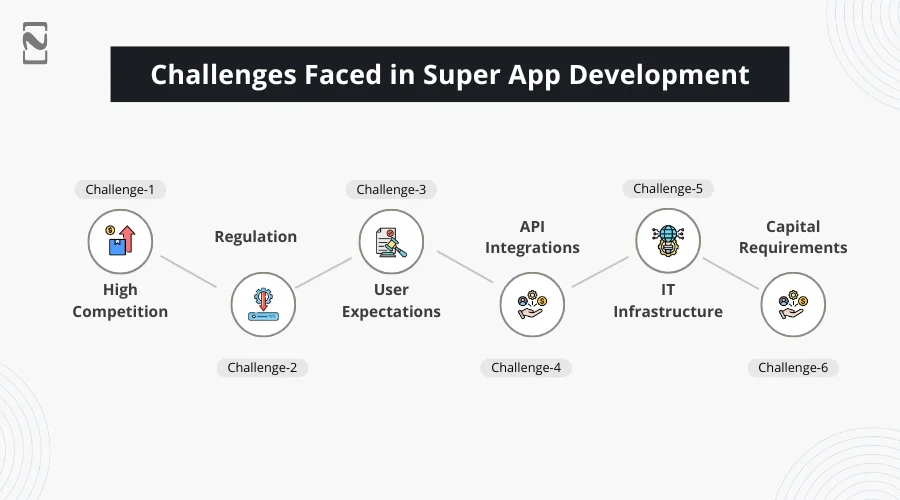
Check out the following list, as we have discussed the challenges you might encounter:
Challenge 1. High Competition
The super app is gaining popularity, leading to more and more businesses coming forward to develop a super app.
To stand out, you need to bring new mobile app ideas to the table and add basic & advanced features that your user wants.
Pay more attention to the market, get to know about the needs of the users, and provide them with that. This will help you stay ahead in the market with a competitive edge.
Challenge 2. Regulation
The demand for these all-in-one solutions is apparent. However, in current times, numerous legal limitations can become issues for app developers to launch the app.
Regulations in countries like China and the USA are tighter than ever, including data privacy requirements and many more.
So, obeying industry-specific rules, legal requirements, and licensing is necessary to establish your ground in different countries.
Challenge 3. User Expectations
While offering a lot of services on one platform is useful for businesses, it can prove to be overwhelming for users.
If your app doesn’t provide a smooth transition between different services, is not easy to navigate, and doesn’t have an intuitive interface, this might cause your user to abandon the app.
Make sure to develop a Super App keeping simplicity and usability in mind with out-of-the-box features that meet user expectations and boost your revenue.
Challenge 4. API Integrations
API integration is an important element of microservices architecture. There are a lot of API integrations available for Super App development.
A common problem with API integration is that it doesn’t support some functionality.
You should utilize the best Android or iOS app development services that can easily manage and handle APIs and third-party integration tools.
Challenge 5. IT Infrastructure
One of the biggest challenges is managing the IT infrastructure itself.
Handling a load of users, keeping their data safe, and providing a seamless experience is a tough nut to crack.
It is not only a time-consuming process but also requires efficient infrastructure. This is one of the big challenges that businesses face.
It is necessary to work with top mobile app development frameworks and optimization algorithm systems to eradicate these problems.
Although this will differ in cost to make a mobile app that you have estimated, it will ensure the running of your super app.
Challenge 6. Capital Requirements
There’s a lot that goes into it, some additional cost to build a super app. And that can be a challenge for many businesses to keep up with.
A lot of apps don’t even reach the market due to capital issues. That’s why one of the leading questions about super app development is, “How do you get funds for your app?”
To avoid being in one of them, you need to make sure to keep more money aside to cover any financial outlays.
Also, to create a unique app, you will need a top-tier team of experienced on-demand app development company that handles your requirements well and deliver outstanding services to you.
Why do you need a team or a service? Well, it takes a series of steps to develop a super app. To get a glimpse of what goes into super app development, check out the next section, where we have listed all the steps!
Super App Development Process: Step-by-Step
To develop a super app, the first thing you need to do is plan your app development process.
Keep in mind that building an app is no joke and will take some time, so you should plan it accordingly.
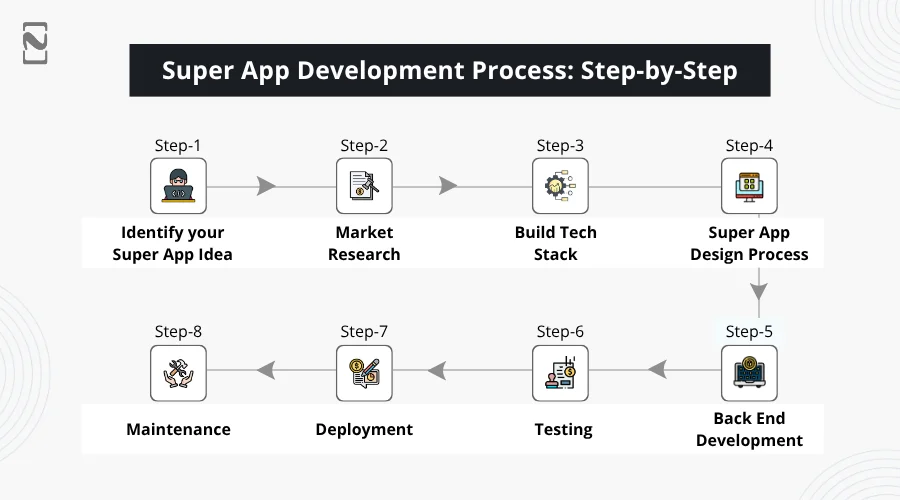
With that out of the way, let’s jump straight into the development process.
Step 1. Come Up With Super App Ideas
The first and foremost step is to come up with a great idea that you think can do well in the market.
How do you do that? You can brainstorm new ideas or take inspiration from the existing ones.
For example, you can launch your super app at once in the market, or, just like the Momo app, you can first start with a service and then expand to other services in your app.
Step 2. Market Research
After you have an idea, it’s time to conduct thorough research about the market. This includes studying your target audience and your competitors.
It is necessary to understand their pain points, find your user base, and look for opportunities to ensure your app is built as per their needs.
Once you find a good idea, you can put the last nail in the coffin by patenting your app idea. So, nobody can replicate the idea and steal your limelight.
Step 3. Build Tech Stack
Mobile app tech stack refers to the technologies that are used to develop mobile apps.
Just like any other app development process, choosing the right stack is a crucial aspect of super app development.
This means picking programming languages, databases, front-end & back-end tools, and APIs. A brief overview of the Super app tech stack is as follows:
| Layer | Technology Options |
| Frontend | React, Angular, Vue.js, Flutter, Xamarin, Swift (for iOS), Kotlin (for Android) |
| Backend | Django (Python), Ruby on Rails (Ruby), Spring Boot (Java), Laravel (PHP) |
| Database | PostgreSQL, MySQL, Microsoft SQL Server, Cassandra, Firebase Realtime Database |
| Authentication | OAuth 2.0, OpenID Connect, Firebase Authentication |
| Real-time Messaging | MQTT, WebSockets, Pusher |
| Payment Gateway | PayPal, Square, Adyen, Authorize.Net |
| Cloud Services | Microsoft Azure, IBM Cloud, DigitalOcean |
| Containerization | Podman, rkt (Rocket), containerd |
| Orchestration | Docker Swarm, Amazon ECS, OpenShift |
| Monitoring | ELK Stack (Elasticsearch, Logstash, Kibana), New Relic, Datadog |
| Search Engine | Apache Solr, Amazon CloudSearch, Algolia |
| Push Notifications | OneSignal, Pusher Beams, AWS SNS |
| Analytics | Mixpanel, Amplitude, Heap Analytics, Matomo (formerly Piwik) |
| Security | OAuth, JWT, HashiCorp Vault, Keycloak |
Super App Architecture
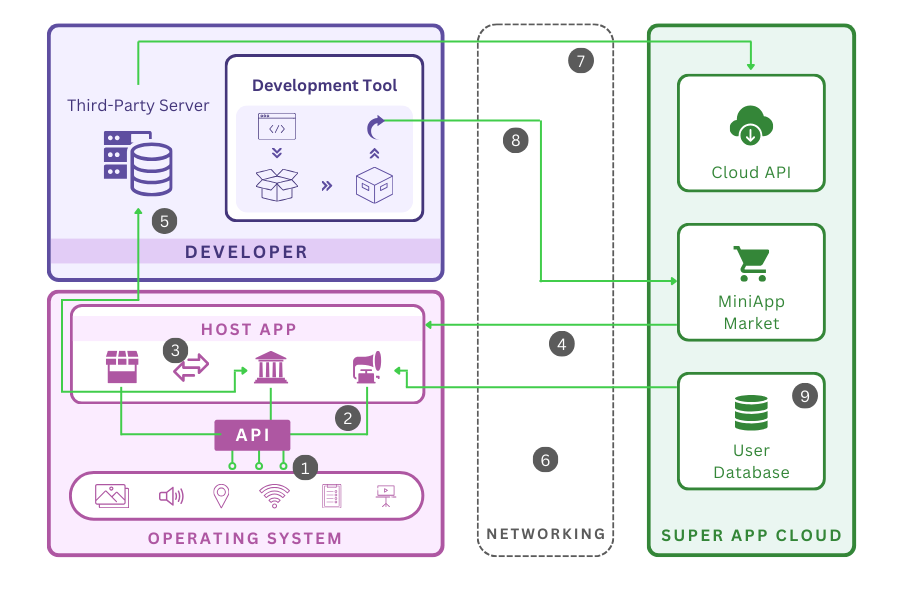
Step 4. Super App Design Process
Since the Super App will be a hub for so many services, it should be easy to navigate and user-friendly.
It is an ongoing process of improving UI and UX elements that includes designing a mobile app prototype and then getting feedback to reach the outcome.
First, UI/UX designers will work on the front end and then move to the back-end part.
Step 5. Back End Development
This is the step where the app development team works on the server-side super app and writes the source code to shape your idea into a final form.
Back-end development makes sure the platform works fine, so it is advisable to have complete communication with the development team to make sure the app is well-developed.
Step 6. Testing
Mobile app testing is the phase where the developed solution is thoroughly tested by the QA team to find bugs, errors, and technical issues that are fixed immediately.
So, once the issues are fixed, it provides an error-free and seamless experience to its users.
It helps to ensure that the app is up to market standards before we can move forward with deployment.
Step 7. Deployment
Once the app is ready, you can add your application to your preferred store. You might think it is pretty easy and will get published easily.
But no, it is not the case; it will take up to 2 weeks to hear from them.
Play Store might be a little lenient on guidelines, but the App Store is stricter with the applications it permits.
Therefore, it’s advised that you ask super app developers for help.
Step 8. Maintenance
The work is far from over; it’s time to utilize mobile app maintenance services essential to make sure the app is functional & runs smoothly.
Since the app is huge and comprises a lot of services, anything can go wrong. You need to maintain it properly by keeping it bug-free and providing new updates.
This is also the time to start mobile app marketing.
Super App Monetization Models
With a thorough understanding of how the development works, you might have realized that it will require a decent investment to get started.
This also means that while you are investing in the application, you should not forget about monetization strategies that will help you recoup the funds.
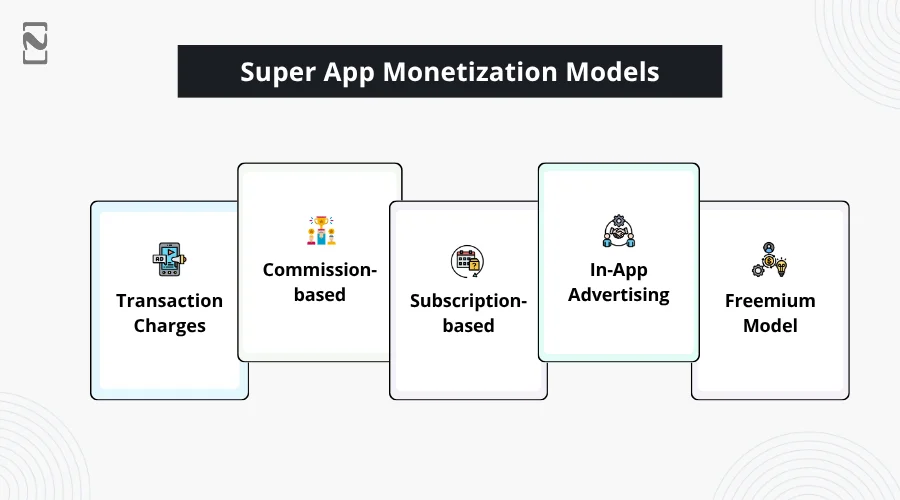
There are multiple ways your Super App can make money! These include –
Model 1. Transaction Charges
The first and easiest way you can earn money through your super app is by charging a transaction fee or a convenience fee.
This is generally an industry norm where you can keep a small portion of the entire transaction as a charge for facilitating the same.
This is a game-changer, as when you have integrated multiple services in the same app, the number of transactions per user might significantly increase, allowing you to earn more.
Model 2. Commission-based
It is one of the most common app monetization models that businesses use to earn money. Your app will provide services like food delivery, grocery delivery, & many more.
Make sure to charge a small amount of commission in the form of a platform fee or other to open up a new revenue stream.
Model 3. Subscription-based
A common revenue stream often seen in subscription-based apps can be utilized in your super app. You can charge users to provide premium features.
For example, if you are providing food delivery in your app, you can ask them to take a subscription to avoid delivery fees and enjoy good discounts and offers.
Model 4. In-App Advertising
In-app advertisement is also a great way to make money, used by a lot of businesses. You can show third-party ads and charge for them.
It also opens up the opportunity for cross-selling your products. Make sure to show relevant ads that are based on their interests.
Model 5. Freemium Model
The freemium model is a mix of free and premium services.
Through your super app, you can provide limited features for free and charge for charges to upgrades to a premium version. This can be a huge revenue-generating system for your user.
List of Top Super Apps
If you want to build your super app, you’d better learn from the best.
Though the market is not filled with these apps, there are a few that have made a name for themselves. If you are planning to develop one for your business, take inspiration from these platforms for a good idea.
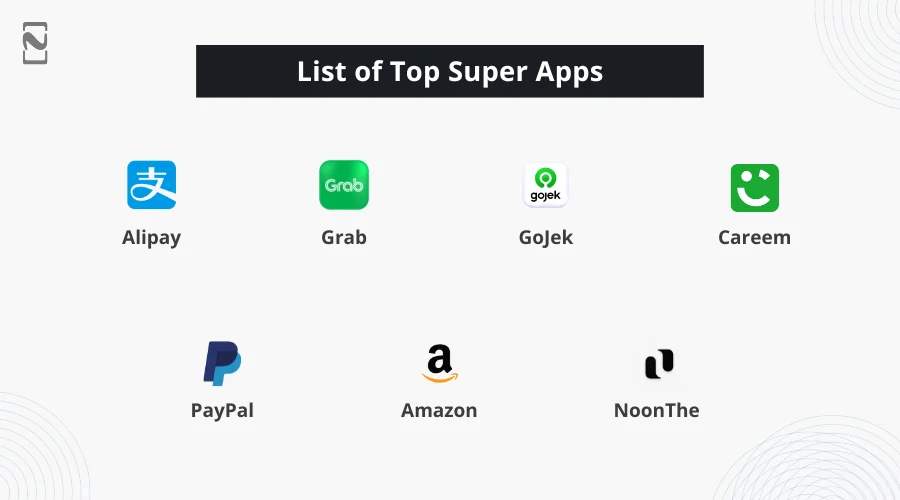
So, let’s get to know the nitty-gritty details of these apps.
1. Alipay
Alipay is one of the best eWallet apps on the market today. Founded in 2004 by Alibaba founder Jack Ma in China.
In recent years, the platform has gone from being an eWallet app to being a super app as it offers a bunch of different features, including:
- Restaurant table booking
- Online food delivery from restaurants
- ECommerce
- Financial Management and much more.
Alipay has expanded globally in countries like Asia, Bangladesh, Japan, the Philippines, Singapore, South Korea, Vietnam, Australia, the United States, and many more.
2. Grab
Here, we have Grab – the everyday everything app.
The Singapore-based super app was founded back in 2012, making it older than a decade.
In addition to being a ride-sharing app, it also offers a range of services covering food delivery, grocery delivery, package delivery, and financial services.
Today, it is available in over 55 cities in Southeast Asia. It is one of the most popular apps, generating billions in revenue.
This is one of the reasons why people often ask, how to build an app like Grab or the cost to build an app like Grab.
3. GoJek
Gojek Super app is based in Indonesia and is an on-demand application.
While it initially started as a call center for courier service, today it has expanded its services to over 20 fields. Three of its top models are, as mentioned below:
- GoRide
- GoSend
- GoMart
Moreover, its service coverage area expands to most of Southeast Asia, covering places like Indonesia, Vietnam, Singapore, Thailand, and the Philippines.
Many people across the world want to build an app like Gojek. If you want to develop one of your own, take a look at Gojek.
4. Careem
Careem introduces itself as an ‘everything app’. The app was launched in 2012 in Dubai, UAE.
If you are looking for an app that can provide you with food delivery services, groceries, cab booking, payment processing, and more, then Careem is the answer.
The app operates in over 100 cities in 12 countries, including Africa, South Asia, the Middle East, and others.
5. PayPal
PayPal has been around for some time. It has made its name as the most secure mobile app for online payment.
The company also recently launched its super-app, which includes blockchain solutions, crypto trading, online shopping, and more.
These are some of the most popular super apps in the market right now. It was the inspiration for a lot of other apps like PayPal that we use or see in the market today.
6. Amazon
Who doesn’t know one of the world’s largest companies, Amazon?
It is one of the best e-commerce platforms in the world. Worth in trillions itself, the company offers its services in almost every part of the world.
Apart from food delivery services in the USA, grocery delivery, and eCommerce, they also offer integrated fintech options like eWallet and online payment.
7. Noon
Noon is quite famous in the Middle Eastern region.
When it comes to electronics, fashion, health and beauty, homeware, or any other, the app provides all kinds of services to its users.
It was established in 2016, and since then, it hasn’t looked back. Currently, the app operates in Egypt, UAE, & Saudi Arabia.
It is so popular that several businesses in the Middle East want to build an app like Noon.
How Much Does it Cost to Develop a Super App?
So, what is the cost to build a super app?
This is one of the leading questions in every investor’s mind. Well, on average, the cost to develop a super app can be from $40,000 to $200,000.
Every business leader wants to know the cost and plan for it, well developing a super app is costly. There is no exact figure we can tell you.
Several factors affect super app development costs, such as features, tech stack used, development team experience, and many more.
For more details on the same, it’s highly recommended that you consult a mobile app development company.
Cost-Affecting Factors for Super App Development
There are lots of factors that affect the cost of making a super app. Knowing about them will help you in managing your finances and budget properly.
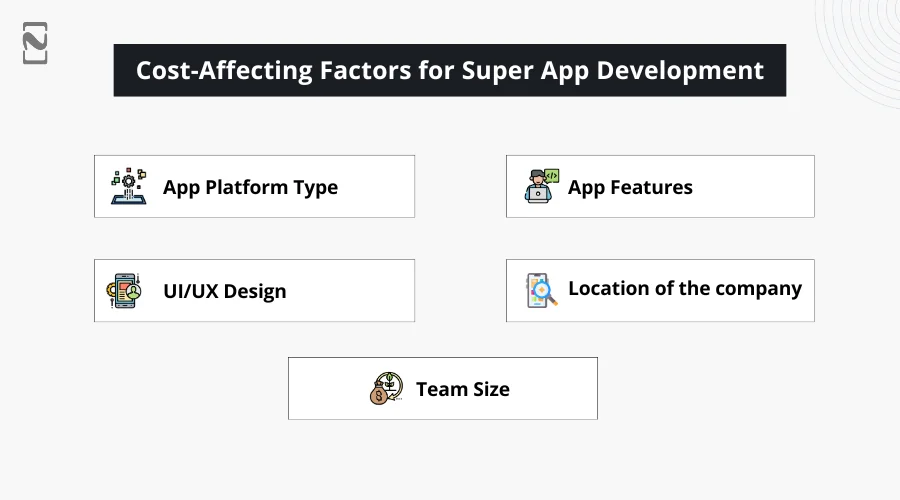
So, without any delay, let’s get to know about them-
1. App Platform Type
Deciding on a platform for your app is a cost-effective factor.
You can choose to build an app for Android, iOS, or cross-platform, depending on your target audience.
The cost can vary a lot, such as Native (Android or iOS) can cost from $40,000-$80,000, whereas cross-platform can cost $30,000 to $60,000.
2. App Features
Another factor that affects your cost to develop a super app is the features. An app with basic features will cost you less than a complex app with extensive features.
Basic features can cost you $10,000 to $30,000, whereas complex features can cost you $30,000 to $80,000.
3. UI/UX Design
The design part can impact your cost to develop a mobile app.
It aims to develop a prototype, UI/UX, and functionalities. The prototypes go through different levels of testing before getting finalized, which will surely increase the cost, depending on the number of tests & techniques.
It can range from $5000 to $12000 for a basic one and $30,000 to $50,000 for a complex one.
4. Location of the company
The location of your chosen app development company can also affect the cost.
For example, developers in Asia or Africa charge less than companies in the USA or UK. Understand this with the table below:
| Country | Hourly Pricing |
| USA | $100-$150 |
| UK | $80-$120 |
| UAE | $60-$70 |
| Australia | $70-$90 |
| Asia | $25-$50 |
5. Team Size
Another cost-affecting factor can be said to be team size. Either you can hire freelancers or a team from an experienced mobile app development company.
If you hire freelancers, it might help you reduce the cost, but it can affect the quality and security of your app as they are not that experienced.
Whereas seeking help from experts of an app development company can cost you a little more, but will be helpful in the long run.
How Nimble AppGenie Can Be the Perfect Partner to Develop a Super App For You?
Super app development is gaining momentum in current times & there is no indication that it will go back. If you have a question in your mind, will the hype of super app development increase shortly?
Well, the answer is “Yes”. With the increasing interest of people to find all services in a single app, the hype will surely rise in the upcoming years.
This time calls to take action and give your idea a push to become the NEXT BIG THING in the market. However, to do so, you need to partner with an experienced super app development company, i.e., Nimble AppGenie.
We have assisted many businesses in setting a benchmark in this dynamic market. We also have a team of highly skilled developers, designers, QA, and more who are determined to deliver robust and secure apps.
One of the best things about Nimble AppGenie is that we work with the latest technologies, such as AI and ML algorithms, to make your app highly functional & future-proof.
Without a doubt, getting your super app developed by us will be a game-changer for your business. If you want to go ahead, contact us for further discussion.
Conclusion
The convenience and comfort of super apps have increased their adoption by users.
We aren’t saying this, but the Gartner study has said that 50% of people worldwide will be users of multiple Super Apps by 2027.
Super app development will be a fruitful decision for your business. It can provide a great experience to your users, simplify your business operations, and boost revenue.
However, choosing a top mobile app development company that understands your requirements, vision, and target audience can revolutionize user interaction & engagement.
Super Apps will be the center of attention in the future; it’s time for you to be a part of this trend.
FAQs
We have gathered some frequently asked questions about super app development and answered them below.
Building a super app allows you to provide users with convenience, a unified experience, and access to multiple services in one place. It can increase user engagement and loyalty, and offer opportunities for cross-selling and monetization.
To build a super app, start by identifying the key services you want to integrate, plan the user experience, design the interface, develop the app using appropriate technologies (e.g., React Native), and integrate APIs or partner with service providers.
The time taken to develop a super app depends on the complexity and features of the project. Highly complex apps with extensive features will take more time than basic apps with simple features. However, the time frame can range from four months to a year, depending on your project.
The cost of building a super app depends on different factors, including features, development team size, location of the company, and much more. However, the cost to build a super app can range from $40,000 to $200,000. This can increase or decrease depending on your project.

Niketan Sharma, CTO, Nimble AppGenie, is a tech enthusiast with more than a decade of experience in delivering high-value solutions that allow a brand to penetrate the market easily. With a strong hold on mobile app development, he is actively working to help businesses identify the potential of digital transformation by sharing insightful statistics, guides & blogs.
Table of Contents

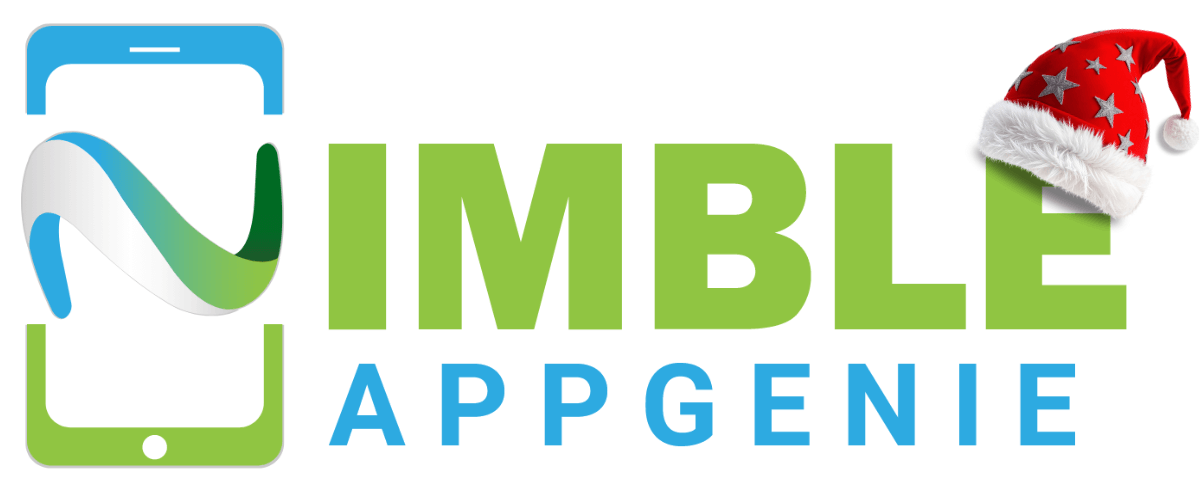





No Comments
Comments are closed.